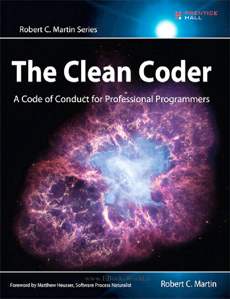The Clean Coder: A Code of Conduct for Professional Programmers

برنامه نویسانی که بردبار هستند و در بحبوبهی فشارهای بی پایان موفق هستند یک ویژگی مشترک دارند: آنها به شدت به نوشتن نرم افزار اهمیت میدهند. آنها آن را به عنوان یک مهارت و هنر در نظر میگیرند و این است که سبب میشود به آنها حرفه ای بگوییم.
در کتاب The Clean Coder: A Code of Conduct for Professional Programmers ، برنامه نویس با سابقه و حرفه ای Robert C. Martin (عمو باب خودمون D: ) ، نظم و انضباط، تکنیک ها، ابزارها و شیوههای ساخت یک نرم افزار واقعی را بیان میکند. در این کتاب مشاورههای کاربردی در مورد همه چیز از تخمین زدن و کدنویسی تا refactoring و تست کردن بیان شده است. در این کتاب بیشتر از تکنیکها پوشش داده شده است و خیلی از نگرشها بیان شده است. Martin نشان میدهد که چگونه میتوان توسعه نرم افزار را همراه با احترام، عزت نفس و افتخار انجام داد؛ خوب و تمیز کار کنیم؛ صادقانه ارتباط داشته باشیم و تخمین بزنیم؛ تصمیمات سخت بگیریم و بفهمیم که هرچقدر دانش بیشتری داشته باشیم مسئولیت بیشتری نیز بر دوش داریم.
Readers will learn
• What it means to behave as a true software craftsman
• How to deal with conflict, tight schedules, and unreasonable managers
• How to get into the flow of coding, and get past writer’s block
• How to handle unrelenting pressure and avoid burnout
• How to combine enduring attitudes with new development paradigms
• How to manage your time, and avoid blind alleys, marshes, bogs, and swamps
• How to foster environments where programmers and teams can thrive
• When to say “No”–and how to say it
• When to say “Yes”–and what yes really means
Great software is something to marvel at: powerful, elegant, functional, a pleasure to work with as both a developer and as a user. Great software isn’t written by machines. It is written by professionals with an unshakable commitment to craftsmanship. The Clean Coder will help you become one of them–and earn the pride and fulfillment that they alone possess.
Table of contents:
Chapter 1 Professionalism
Chapter 2 Saying No
Chapter 3 Saying Yes
Chapter 4 Coding
Chapter 5 Test Driven Development
Chapter 6 Practicing
Chapter 7 Acceptance Testing
Chapter 8 Testing Strategies
Chapter 9 Time Management
Chapter 10 Estimation
Chapter 11 Pressure
Chapter 12 Collaboration
Chapter 13 Teams and Projects
Chapter 14 Mentoring, Apprenticeship, and Craftsmanship
 می پسندم
می پسندم
 به درد نمی خوره
به درد نمی خوره
















